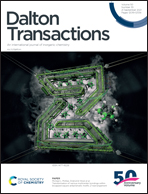Electrocatalytic nitrate reduction with Co-based catalysts: comparison of DIM, TIM and cyclam ligands†
Abstract
Over the past century, the global concentration of environmental nitrate has increased significantly from human activity, which has resulted in the contamination of drinking water and aquatic hypoxia around the world, so the development of effective nitrate-reducing agents is urgent. This work compares three potential macrocycle-based nitrate reduction electrocatalysts: [Co(DIM)]3+, [Co(cyclam)]3+ and [Co(TIM)]3+. Although all three complexes have similar structures, only [Co(DIM)]3+ has been experimentally determined to be an active electrocatalyst for selective nitrate reduction to produce ammonia in water. While [Co(cyclam)]3+ can reduce aqueous nitrate to ammonia and hydroxylamine at heavy metal electrodes, [Co(TIM)]3+ is inactive for the reduction of nitrate. As an initial step to understanding what structural and electronic properties are important for efficient electrocatalysts for nitrate reduction, density functional theory (DFT) was employed to investigate the electronic structure of the three Co complexes, with the reduction potentials calibrated to experimental results. Moreover, DFT was employed to explore four different reaction mechanisms for the first steps of nitrate reduction. The calculated reaction barriers reveal how a combination of electron transfer in a redox non-innocent complex, substrate binding, and intramolecular hydrogen bonding dictates the activity of Co-based catalysts toward nitrate reduction.



 Please wait while we load your content...
Please wait while we load your content...
